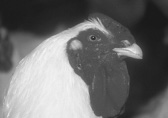



Can Salmonella be Eliminated from U.S. Poultry Flocks?
Published in Poultry Health Report - Fall/Winter 2007 a National Institute for Animal Agriculture Publication. Dr. C. Stephen Roney, veterinary medical officer for the National Poultry Improvement Plan (NPIP) of the U.S. Department of Agriculture’s Animal & Plant Health Inspection Service (USDA/APHIS) said he doesn’t believe Salmonella can be eliminated entirely from U.S. poultry flocks.“But it can be controlled,” he told those attending the recent joint meeting of the United States Animal Health Association and American Associates of Veterinary Laboratory Diagnosticians.
Dr. Roney said controlling Salmonella starts with effective biosecurity measures— from backyard flocks to large production units. He defines biosecurity as farm, personnel and management factors that are used to prevent the introduction of disease organisms into a flock of birds.
 |
- Location & layout of buildings
- Ease of cleaning & disinfecting
- Away from other birds
- Restriction of visitors
- Plan for litter & dead bird disposal
- Water source & quality
- Access for bird movement
- Purchasing replacement birds from Salmonella-free breeding stock
- Using NPIP-certified Salmonella clean hatcheries
- Selecting Salmonella-free feedstuffs
- An effective rodent & pest control program
- Education & training
“NPIP is a cooperative industry-statefederal program that focuses on new technology that can effectively applied to improve poultry and poultry products throughout the country,” he explained.
In his presentation, Dr. Roney referred to four categories of Salmonella: those devastating to the production of poultry; those that cause disease in people but not in poultry; those that cause disease in poultry and/or people; and those that cause no disease in people or poultry.
In the “Salmonella affecting poultry only” category, Dr. Roney noted that Salmonella pullorum (pullorum disease) has a baby chick mortality rate of up to 80 percent and limited industry growth in the 1920s. In 1927 a rapid serum test antigen was discovered, followed by a stained antigen in 1931. Four years later, NPIP was formed, and an effort to eradicate Salmonella pullorum and Salmonella gallinarum (fowl typhoid) was launched.
Although pullorum disease was essentially eradicated in 1965, pullorum was found again in backyard poultry flocks in 2001 and 2002. Currently 43 states are considered to be pullorum-typhoid free.
A strain of Salmonella that affects both poultry and humans, Samonella enteritidis (SE), is a human pathogen transmitted in intact shell eggs.
An NPIP SE control program has been in effect since 1989 for egg-type breeders and for meat-type chickens since 1994.
Dr. Roney reported that SE has steadily declined in egg-type breeders since the mid- 1990s, but has shown an increase this year. This recent increase appears to follow the cycle of slight rises every five to six years.
February 2008











